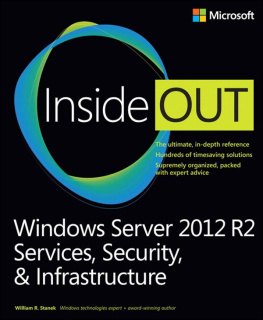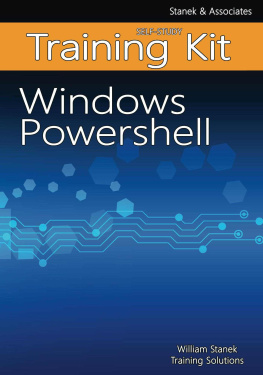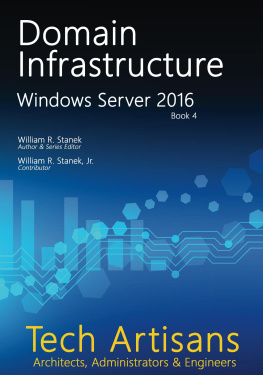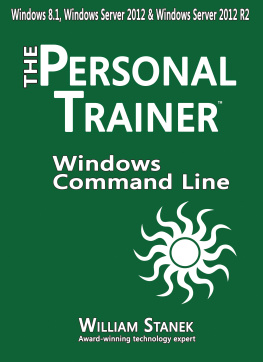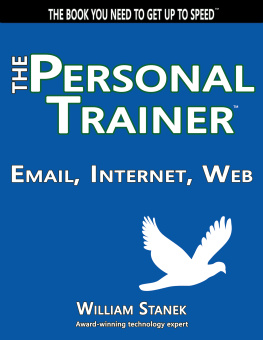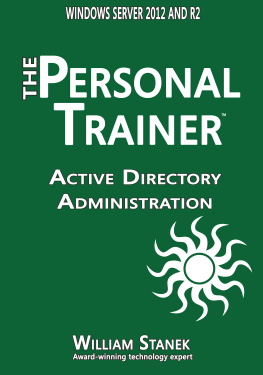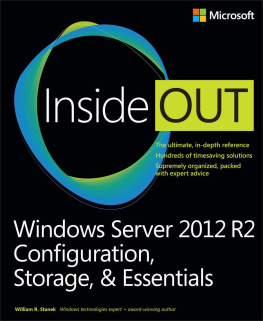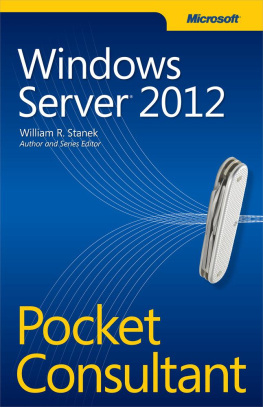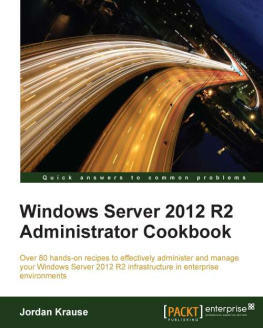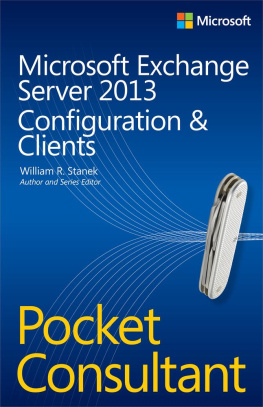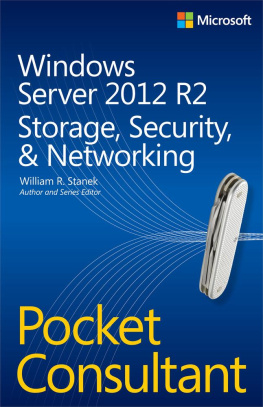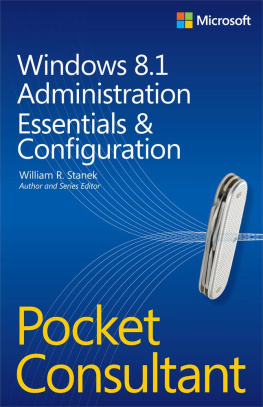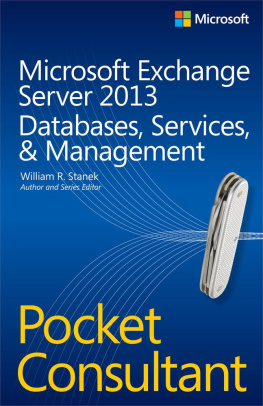Windows Server 2012 R2 Essentials & Configuration
Pocket Consultant
William R. Stanek
Published by Microsoft Press
Acknowledgments
To my readersthank you for being there with me through many books and many years. It has been an honor and a privilege to be your pocket consultant.
To my wifefor many years, through many books, many millions of words, and many thousands of pages shes been there, providing support and encouragement and making every place weve lived a home.
To my kidsfor helping me see the world in new ways, for having exceptional patience and boundless love, and for making every day an adventure.
To Anne, Karen, Martin, Lucinda, Juliana, and many others whove helped out in ways both large and small.
Special thanks to my son Will for not only installing and managing my extensive dev lab for all my books since Windows 8 Pocket Consultant but also for performing check reads of all those books.
William R. Stanek
Introduction
Welcome to Windows Server 2012 R2 Pocket Consultant: Essentials & Configuration . Over the years, Ive written about many different server technologies and products, but the one product I like writing about the most is Windows Server. Anyone transitioning to Windows Server 2012 R2 from Windows Server 2012 might be surprised at just how much has been updated, because changes both subtle and substantial have been made throughout the operating system. For anyone transitioning to Windows Server 2012 R2 from Windows Server 2008 R2 or an earlier release of Windows Server, Ill let you know right up front that I believe Windows Server 2012 and Windows Server 2012 R2 are the most significant updates to Windows Server since the introduction of Windows 2000 Server.
The good news is Windows Server 2012 R2 builds off the same code base as Windows 8.1. This means that you can apply much of what you know about Windows 8.1 to Windows Server 2012 R2, including how Windows works with touchscreen devices. Although you might not install Windows Server 2012 R2 on touchscreen computers, you can manage Windows Server 2012 R2 from your touchscreen computers. If you do end up managing it this way, understanding the touchscreen options and the revised interface options will be crucial to your success. For this reason, I discuss both the touchscreen options and the traditional mouse and keyboard techniques throughout this book.
When you are working with touchscreen computers, you can manipulate on-screen elements in ways that werent possible previously. You can enter text by using the on-screen keyboard and also in the following ways:
Tap . Tap an item by touching it with your finger. A tap or double-tap of elements on the screen generally is the equivalent of a mouse click or double-click.
Press and hold . Press your finger down and leave it there for a few seconds. Pressing and holding elements on the screen generally is the equivalent of a right-click.
Swipe to select . Slide an item a short distance in the opposite direction compared to how the page scrolls. This selects the items and also might bring up related commands. If pressing and holding doesnt display commands and options for an item, try using swipe to select instead.
Swipe from edge (slide in from edge) . Starting from the edge of the screen, swipe or slide in. Sliding in from the right edge displays the charms. Sliding in from the left edge shows open apps and allows you to easily switch between them. Sliding in from the top or bottom edge shows commands for the active element.
Pinch . Touch an item by using two or more fingers, and then move the fingers toward each other. Pinching zooms out.
Stretch . Touch an item by using two or more fingers, and then move the fingers away from each other. Stretching zooms in.
Because Ive written many top-selling Windows Server books, I was able to bring a unique perspective to this bookthe kind of perspective you gain only after working with technologies for many years. As youve probably noticed, a great deal of information about Windows Server 2012 R2 is available on the web and in other printed books. You can find tutorials, reference sites, discussion groups, and more to make using Windows Server 2012 R2 easier. However, the advantage of reading this book is that much of the information you need to learn about Windows Server 2012 R2 is organized in one place and presented in a straightforward and orderly fashion. This book has everything you need to customize Windows Server 2012 R2 installations, master Windows Server 2012 R2 configurations, and maintain Windows Server 2012 R2 servers.
In this book, I teach you how features work, why they work the way they do, and how to customize them to meet your needs. I also offer specific examples of how certain features can meet your needs, and how you can use other features to troubleshoot and resolve issues you might have. In addition, this book provides tips, best practices, and examples of how to optimize Windows Server 2012 R2. This book wont just teach you how to configure Windows Server 2012 R2, it will teach you how to squeeze every last bit of power out of it and make the most from the features and options it includes.
Unlike many other books about administering Windows Server 2012 R2, this book doesnt focus on a specific user level. This isnt a lightweight beginner book. Regardless of whether you are a beginning administrator or a seasoned professional, many of the concepts in this book will be valuable to you, and you can apply them to your Windows Server 2012 R2 installations.
Who is this book for?
Windows Server 2012 R2 Pocket Consultant: Essentials & Configuration covers all editions of Windows Server 2012 R2. The book is designed for the following readers:
Current Windows system administrators
Accomplished users who have some administrator responsibilities
Administrators upgrading to Windows Server 2012 R2 from previous versions
Administrators transferring from other platforms
To pack in as much information as possible, I had to assume that you have basic networking skills and a basic understanding of Windows Server. With this in mind, I dont devote entire chapters to explaining Windows Server architecture, Windows Server startup and shutdown, or why you want to use Windows Server. I do, however, cover configuration, remote management, directory services, security, and much more.
I also assume that you are fairly familiar with Windows commands and procedures and the Windows user interface. If you need help learning Windows basics, you should read other resources (many of which are available from Microsoft Press).
How this book is organized
Rome wasnt built in a day, and this book wasnt intended to be read in a day, in a week, or even in a month. Ideally, youll read this book at your own pace, a little each day as you work your way through all the features Windows Server 2012 R2 has to offer. This book is organized into 10 chapters. The chapters are arranged in a logical order, taking you from planning and deployment tasks to configuration and maintenance tasks.
Ease of reference is an essential part of this hands-on guide. This book has an expanded table of contents and an extensive index for finding answers to problems quickly. Many other quick-reference features have also been added to the book, including quick step-by-step procedures, lists, tables with fast facts, and extensive cross references.



